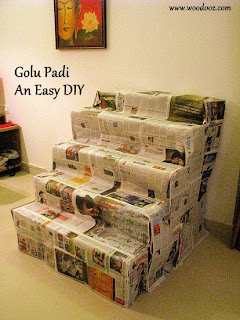This is the final post in the golu padi series. This one will be about the assembly of the golu steps. Do ensure you check out the two earlier posts. I am a bit relieved that we don't have to go in search of bricks, card boards, or left over planks to build the steps like we did the last two years.
Before you read the rest of the post, do spend some time to understand what a pilot hole is and what is a cross dowel. These two concepts are essential to get a better grip of the post / video.
Since the video is a little elaborate, I will write only a bit about what needs to be done with pictures.
Disclaimer : Materials used and measurements depicted are suited for the collection of dolls we have. Kindly assess your collection and accordingly choose 12mm / 19 mm ply for your steps.Check Out ! Complete guide to build your own Golu steps
 |
| The Golu Padi - Final look |
Step 1
Join the vertical teak wood support with the horizontal strip of wood. Drive pilot holes and use the nuts and bolts to tighten the wooden pieces.
Do this on both sides of the plywood strip to get the basic support structure in place. (Watch video to know how this is done)
Join the side risers with the vertical teak wood support. Make sure the top rear of the side step is aligned with the wall, and the bottom is parallel and placed on the floor. This is critical to get the required stability. Again, use pilot holes, nuts and bolts. (Watch video to know how this is done)
 |
| Side riser joined to the vertical support |
 |
| Other side riser attached to the 2nd vertical stem |
Step 3
With side risers in place, start joining the steps (padis) to the sides. You can screw the step planks to the side steps, but then, it would make assembling and dismantling on a regular basis a pain. To overcome this, use nuts and bolts the way cross dowels are used in the flat pack furniture industry (Watch video to know how this is done).
Start with the top step. Use two bolts on both sides of the planks.
 |
| Start adding the step planks - Top one added |
Keep adding all the other steps in sequence. For the 2nd, 3rd and 4th padis, it is enough you use only one bolt on both sides.
For the bottom step, use two bolts on both sides. This will ensure the steps do not split at the bottom.
Finally, evaluate your outcome. Think the steps are wobbly ? Check if the bolts are sufficiently tight. If required include an additional horizontal support connecting the two teak wood vertical stems on the top. And most important : If you know someone who would benefit from this post, do remember to share it. Just click on one of the share options at the end of this post :)
 |
| All the step planks joined with the side risers |
Happy Navaratri











+DIY.jpg)

.jpg)






